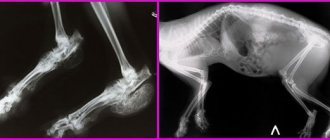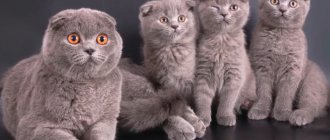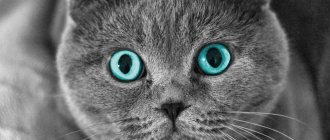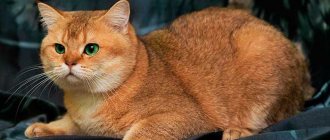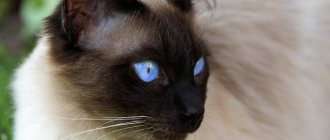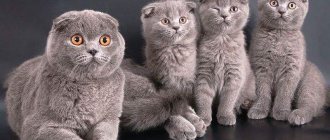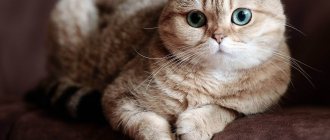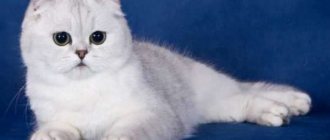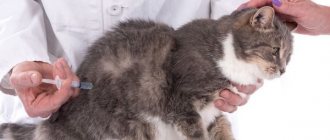Symptoms and signs
Scottish Fold kittens are resistant to hereditary diseases, develop well, are playful and loving. However, sometimes osteochondrodysplasia affects the offspring. This hereditary disease is characterized by deformation processes in bone tissue.
Signs of the disease:
- a short tail that is not mobile;
- shortened paws with obvious signs of curvature.
Sick cats limp - this is the main symptom of the disease. Their shortened tails are inactive, sometimes becoming completely stiff. Kittens do not want to jump and run. The appearance of a “stilted” gait indicates the progression of the disease.
Most often, osteochondrodysplasia affects the breed during improper crossing, when two cats with floppy ears are brought together. A defect in endochondral ossification leads to morphological changes in the axial and peripheral skeleton, destruction of joints, formation of growths and changes in cartilage tissue.
Osteochondrodysplasia (OCSD) most often affects Scottish cats and some breeds of large, fast-growing dogs.
The disease manifests itself as difficulty in the animal's movement. It is difficult to notice this feature of a pet at the initial stage of development: with a small body weight, the cat can redistribute the load on healthy limbs. The pain syndrome provokes the pet’s refusal to run and jump. As the animal grows, it acquires an unnatural gait: diseased joints cannot withstand the load of the skeleton. Deformed limbs bend poorly, tails are shortened, and have a thin base.
The disease can be detected in the first weeks of a kitten's life. The clinical picture of the disease worsens with age.
How to treat a cat with osteochondrodysplasia
In isolated cases, surgical treatment is indicated for the pet, but it does not always bring positive results. Most often, painkillers and anti-inflammatory drugs are prescribed to improve the animal’s quality of life.
The prognosis of the disease depends on the severity and development of the problem.
There is no definitive, single correct treatment option for osteochondrodysplasia; the result varies depending on the severity of the disease. In some cats, dysplasia can lead to an irreversible decrease in quality of life, while others may compensate by compensating for short limbs with decreased mobility.
The problem is that this increases the risk of obesity. Obesity is one of the common side effects of osteochondrodysplasia. To solve the problem, the cat must adhere to a strict diet, and owners should monitor the pet’s weight and physical activity. Additionally, since it is a bone disease, arthritis is more likely to develop as you age. All painkillers should be used with caution and only as prescribed by a veterinarian.
Sign up for treatment of osteochondrodysplasia
POLAR BEAR
The veterinary clinic in Nizhny Novgorod "White Bear" provides all types of services for cats and dogs.
Conducts any examinations and tests in its own veterinary laboratory; the clinic operates a veterinary ambulance for animals and a 24-hour veterinarian is on call at home. Agreement on the processing of personal data
Public offer
SITE MENU
- About the clinic
- Price list for veterinary clinic services
- Treatment
- Services
- Price list for veterinary clinic services
- Vetapteka
- Contacts
- Site Map
CONTACTS
- Nizhny Novgorod st. Vyatskaya 7
- 8 (831) 437-25-27
- [email protected]
Diagnosis and treatment
The main method for diagnosing OCD is radiography. Using the method, we determine:
- changes in the shape of the skeleton, cartilage tissue;
- expansion or narrowing of joint spaces;
- the presence of exostoses, which can spread to the heel bone.
Osteochondrodysplasia of Scottish fold cats, the symptoms of which in the initial stages of development can be seen after taking an x-ray and observing the animal, is a serious disease. Treatment is aimed at achieving a palliative effect. It will not be possible to completely cure the animal, but it is not so difficult to alleviate its condition. Pentotan polysulfate and non-steroidal anti-inflammatory drugs are used.
Despite the fact that the disease has no specific treatment, the presence of constant pain requires monitoring the use of chondroprotectors.
Shock wave therapy for acute diarrhea
It is a relatively new technique in rehabilitation. It is successfully used by veterinarians to treat many diseases of the musculoskeletal system. A course of 6-10 procedures allows you to relieve pain in an animal and improve joint mobility. Although shock wave therapy cannot completely cure the disease, its use in the early stages promotes normal development of kittens. Pets in adulthood, after completing the full course, become more mobile.
The method is based on the effect of cavitation - the propagation of low-frequency acoustic waves throughout the animal's body. As a result of the procedure, fluid outflows and pathological formations are destroyed.
Shock wave therapy does not require the cat to stay in the hospital. The procedure can be carried out by a veterinarian if equipment is available in a special room.
Radiation therapy: an innovative method
Currently, treatment is carried out using radiation therapy. This procedure was developed in England, where it is successfully used on sick animals. Proven effectiveness. Carrying out a course of radiation helps to eliminate pain and prevents further destruction of cartilage and skeleton.
Diagnostics
In order to suspect osteochondrodysplasia in a kitten, an external examination may be sufficient for a veterinarian. But to determine how far the osteoarticular deformation has gone, X-rays are taken.
The most characteristic changes affect the lower limbs, with the hind legs suffering much more than the front legs. An x-ray will show exostoses in the heel area - massive, hard osteochondral growths that resemble a tumor. The bones of the phalanges, metatarsus, and tarsal joints themselves are deformed, and the joint spaces are narrowed or absent.
How long do sick cats live?
No one can make a specific forecast of the life expectancy of a sick cat. Even the attending veterinarian will not take responsibility for determining dates and deadlines. Some veterinarians suggest euthanizing the animal after diagnosis. But with the right selection of medications, treatment methods and professional care, the pet’s condition can be significantly improved.
How to understand that osteochondrodysplasia of Scottish fold cats is present, how long animals live, how the disease progresses are questions of interest to kitten buyers. It is worth noting that only a few kittens develop the disease in the first weeks of life. Very often it is possible to make a diagnosis when the pet has already found a permanent owner and has become a family favorite. Therefore, when choosing a kitten, it is recommended to carefully examine the paws and tail: the presence of curvature, deformation, kinks, and poor mobility can be signs of a serious disease.
The severity of the disease, the rate of joint destruction, and life expectancy vary greatly in different clinical cases. Veterinarians recommend monitoring the condition of cats and contacting a professional clinic at the first signs of illness.
Forecasts
The lifespan of Scottish cats affected by osteochondrodysplasia is difficult to predict in advance. It largely depends on how willing the owners are to care for a disabled kitten.
For long-term prognosis, it is necessary to exclude other genetic diseases of Scottish cats, which can occur with irresponsible breeding as often as osteochondrodysplasia. These are polycystic kidney disease and hypertrophic cardiomyopathy, which can be detected using ultrasound.
With mild osteochondrodysplasia, cats can live for years, although they require constant supportive treatment and special housing conditions. For example, they may find it painful to go to the toilet, which leads to urination in the wrong places and chronic constipation.
If the sick kitten is homozygous for the lop-eared gene (both parents are Scottish Folds), the prognosis for life is extremely unfavorable. Bone deformation causes severe pain, which becomes increasingly difficult to relieve with age. The animal cannot move, and at some point the owners resort to euthanasia as a means of ending the suffering of their beloved pet.
Nutrition correction
Nutrition of a sick animal is an important point in maintaining health. Sick cats are prescribed special feed additives that have a beneficial effect on joints and prevent fractures. A balanced diet is also very important. You can use both natural products and ready-made feed mixtures - complexes that contain microelements and vitamins.
The food should be rich in calcium, phosphorus, iodine, and iron. The presence of vitamins B and E is very important.
Making a diagnosis is not a death sentence. Love and patience will help you cope with the disease. Accepting the challenge or giving up is an individual decision. Only the owner of the animal can make the choice.
Constipation in a Scottish Fold cat
One of the common diseases in both Straight Fold and Scottish Fold cats is constipation. This pathology is characterized by a slowdown in intestinal motility, in which feces cannot move normally to the anus.
As a result of the formation of a large number of decay products, intoxication and flatulence occur. In severe cases, intestinal volvulus or rupture occurs.
Causes of coprostasis in Scottish fold cats:
- regular ingestion of large amounts of wool;
- functional liver disorders;
- inflammatory and infectious diseases of the gastrointestinal tract;
- malignant and benign neoplasms in the intestine;
- helminthic infestation;
- entry of household waste into the gastrointestinal tract;
- blockage of the intestinal lumen with chicken and fish bones;
- insufficient fluid intake;
- adhesions formed after abdominal surgery.
The first symptoms of constipation in cats:
- the animal’s behavior indicates pain when attempting to empty the bowel;
- feces look like small ropes or ribbons that come out very slowly under pressure;
- the pet growls or meows pitifully over the tray.
Further attempts to empty the bowel cease to produce results and the clinical picture worsens. The following symptoms appear:
- hard belly;
- pain in the abdominal area on palpation;
- refusal of food;
- bad breath.
With severe intoxication, convulsions, tremors of the limbs and coma may occur.
To find out the causes of coprostasis and determine the method of treatment, you need to send the animal to the clinic. Your veterinarian may use contrast-enhanced x-rays to look for adhesions, growths, or bone plugs in your cat's intestines.
As a treatment, methods of influencing the root cause of constipation are chosen. And as an emergency, laparotomy is used. During this procedure, stool is removed surgically (through an incision in the abdomen).
To prevent abdominal surgery, you must:
- Introduce into the Scottish Fold cat's diet supplements that stimulate the proliferation of lacto- and bifidobacteria, suppress pathogenic microflora, and enhance intestinal motility.
- Regularly use the paste to remove hair from the stomach.
- Maintain water balance in the cat's body.
- Alternate dry and wet food.
- Provide sufficient physical activity.
At the first sign of constipation, you can administer Vaseline oil orally to your cat. But due to its specific taste, animals are reluctant to swallow it. Therefore, it is worth using the help of another person.
Otitis in fold-eared cats
Curled ears and a narrow ear canal are factors that contribute to the development of otitis externa in the Scottish Fold. By slowing down air circulation, the temperature and humidity in the ear increases.
This creates optimal conditions for the development of pathogenic microflora, which causes inflammatory processes.
Other root causes of otitis externa in Scottish Fold cats include:
Secondary causes include bacterial and yeast infections, as well as improper treatment of existing primary otitis media.
Symptoms of external otitis in Scottish Fold cats:
- hyperemia and swelling of the external ear;
- itching and soreness;
- the appearance of an unpleasant odor from the ear;
- increase in the amount of secretion released.
Methods for diagnosing external otitis in cats:
- inspection and palpation;
- otoscopy;
- microscopy of scraping secretions from the ear canal for the presence of parasites.
To identify structural anomalies and the presence of tumors in the middle and inner ear of Scottish Fold cats, radiography or video otoscopy is used. For the final examination, general anesthesia is used.
Treatment comes down to eliminating the cause of the disease and symptomatic therapy, which includes:
- sanitation of the external auditory canal with special lotions or warm saline;
- external anti-inflammatory drops;
- antimicrobial ointments.
Important! If the integrity of the eardrum is damaged, the use of drops is contraindicated. Therefore, it is strictly forbidden to self-medicate otitis media in cats.
When the animal's general body temperature increases, the veterinarian prescribes antibiotics.
If ticks are present, antiparasitic medications for cats are used.
The tumors are removed surgically, and allergic reactions are treated under the supervision of a doctor with diet and antihistamines.
If untreated, inflammation spreads to the middle and inner ear, melting of the structural elements of the organ occurs, which can lead to inflammation of the brain and meninges, as well as the development of sepsis when infection enters the blood.
